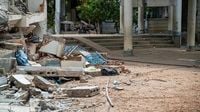On March 28, 2025, Myanmar was rocked by a magnitude 7.7 earthquake that tore across the Sagaing Fault, a colossal north-south boundary slicing through the country. The quake, which left thousands dead and caused widespread destruction, has quickly become a touchstone for scientists seeking to understand the volatile behavior of strike-slip faults worldwide. But the story doesn’t end at Myanmar’s borders. According to a pair of studies published August 11, 2025, in Proceedings of the National Academy of Sciences (PNAS), the lessons learned from this disaster could have far-reaching implications for earthquake-prone regions like California, where the infamous San Andreas Fault looms large in the public imagination.
At first glance, the Sagaing Fault and the San Andreas Fault might seem like distant cousins, separated by continents and cultures. But dig a little deeper, and their similarities are striking: both are long, relatively straight strike-slip faults, where massive slabs of the Earth’s crust grind horizontally past each other. For decades, seismologists have warned that the San Andreas is overdue for “the big one.” Now, thanks to the devastation in Myanmar, they may have a clearer sense of just how unpredictable—and potentially catastrophic—such an event could be.
What set the Myanmar quake apart wasn’t just its strength, but its scale and speed. According to the Caltech research team, the earthquake split the Sagaing Fault at speeds exceeding 3 miles (4.8 kilometers) per second—an astonishing rate that left both scientists and residents reeling. Even more surprising was the sheer length of the rupture: satellite images revealed that over 311 miles (500 kilometers) of the fault slipped during the quake, far more than the 186 miles (300 kilometers) that researchers had predicted based on historical records.
“We use remote sensing observations to document surface deformation caused by the 2025 Mw7.7 Mandalay earthquake,” the researchers wrote in PNAS. “This event is a unique case of an extremely long (~510 km [317 miles]) and sustained supershear rupture probably favored by the rather smooth and continuous geometry of this section of the structurally mature Sagaing Fault.”
The new study, led by postdoctoral researcher Solène Antoine at Caltech, harnessed cutting-edge satellite imaging techniques to track how the ground shifted during and after the quake. These methods, Antoine explained, “allow us to measure ground displacements at the fault”—especially in directions that older techniques struggled to detect. The results were eye-opening: the eastern side of the fault moved a staggering 9 feet (3 meters) south relative to the western side, a net displacement that dwarfed expectations and forced a re-examination of how such faults accumulate and release stress.
For years, earthquake forecasts have relied heavily on the so-called seismic gap hypothesis: if a segment of a fault hasn’t slipped in a long time, it’s likely to “catch up” with a big quake, releasing pent-up energy. In Myanmar, researchers had pinpointed a 186-mile (300-kilometer) stretch of the Sagaing Fault that hadn’t experienced a major event since 1839. But when the earth finally moved, it didn’t stop there. The rupture extended over an additional 124 miles (200 kilometers), showing that these faults can behave in ways that defy even the best-laid scientific predictions.
“The study shows that future earthquakes might not simply repeat past known earthquakes,” said Jean-Philippe Avouac, director of Caltech’s Center for Geomechanics and Mitigation of Geohazards and senior author of the study. “Successive ruptures of a given fault, even as simple as the Sagaing or the San Andreas faults, can be very different and can release even more than the deficit of slip since the last event.”
What does this mean for places like California? For one, it calls into question the reliability of traditional, time-independent earthquake risk models—those that estimate the likelihood of a major quake occurring over set periods (like 30 years) without accounting for recent fault movement or the specific location and size of past slips. “In addition, historical records are generally far too short for statistical models to represent the full range of possible earthquakes and eventual patterns in earthquake recurrence,” Avouac explained. “Physics-based models provide an alternative approach with the advantage that they could, in principle, be tuned to observations and used for time-dependent forecast.”
In other words, the Myanmar quake is a wake-up call: even faults that appear simple and well-understood can surprise us, producing earthquakes that are bigger, longer, and more complex than anything on record. The study’s findings suggest that future risk assessments—especially for urban areas straddling major faults—must consider not just the long-term odds, but the specific history and recent behavior of each fault segment. It’s a subtle but crucial shift that could make the difference between being caught off guard and being prepared.
The research, which involved an international team and support from the National Science Foundation, the U.S. Geological Survey, and the Statewide California Earthquake Center, underscores the value of real-time data and advanced imaging in the fight to understand and mitigate earthquake risk. As Solène Antoine put it, “This earthquake was the perfect case to test our new imaging methods.” These tools, she added, “allow scientists to measure how much the ground moved, especially in directions that older techniques couldn’t detect well.”
Of course, even the most sophisticated models can’t yet predict exactly when or where the next big quake will strike. But each new event, each fresh set of observations, brings scientists one step closer to unraveling the mysteries of the Earth’s restless crust. The hope, echoed by researchers and policymakers alike, is that these lessons will translate into better preparedness and, ultimately, saved lives.
As Myanmar begins the long road to recovery, its tragedy has become a catalyst for scientific progress—a stark reminder that nature’s forces are both unpredictable and, at times, brutally instructive. For those living along the world’s great faults, from California to Southeast Asia, the message is clear: the ground beneath our feet is never as stable as it seems.
